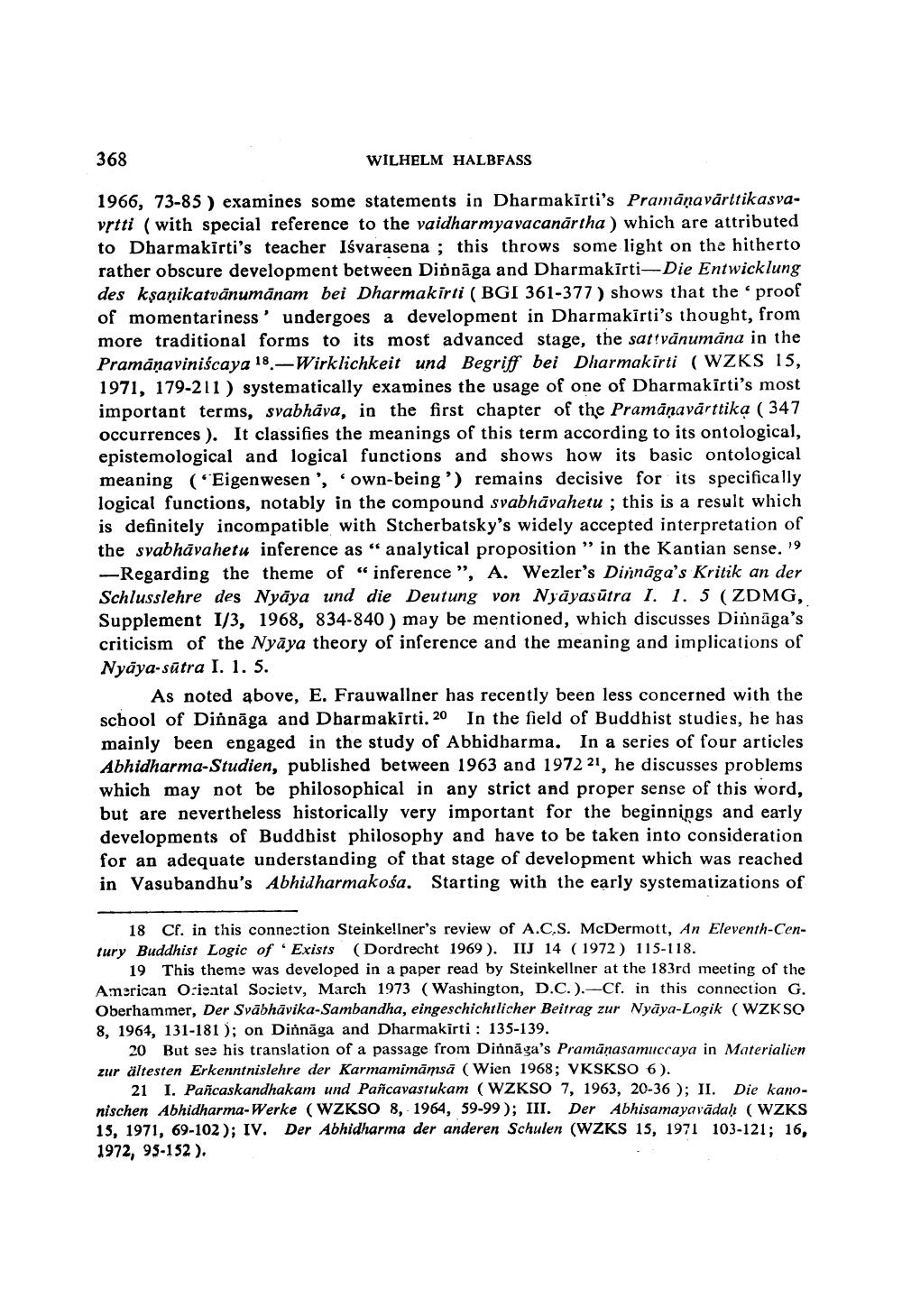________________
368
WILHELM HALBFASS
1966, 73-85 ) examines some statements in Dharmakīrti's Pramāņavārttikasvavrtti (with special reference to the vaidharmyavacanārtha ) which are attributed to Dharmakirti's teacher Iśvarasena ; this throws some light on the hitherto rather obscure development between Diönāga and Dharmakīrti-Die Entwicklung des kşaņikatvānumānam bei Dharmakirti ( BGI 361-377) shows that the proof of momentariness' undergoes a development in Dharmakīrti's thought, from more traditional forms to its most advanced stage, the sattvānumāna in the Pramāņaviniscaya 18.-Wirklichkeit und Begriff bei Dharmakirti (WZKS 15, 1971, 179-211 ) systematically examines the usage of one of Dharmakirti's most important terms, svabhāva, in the first chapter of the Pramāņavārttika ( 347 occurrences ). It classifies the meanings of this term according to its ontological, epistemological and logical functions and shows how its basic ontological meaning ("Eigenwesen', 'own-being') remains decisive for its specifically logical functions, notably in the compound svabhāvahetu ; this is a result which is definitely incompatible with Stcherbatsky's widely accepted interpretation of the syabhāvahetu inference as "analytical proposition" in the Kantian sense. 19 - Regarding the theme of “inference ", A. Wezler's Dinnāga's Kritik an der Schlusslehre des Nyāya und die Deutung von Nyāyasūtra 1. 1. 5 (ZDMG, Supplement 1/3, 1968, 834-840 ) may be mentioned, which discusses Dinnāga's criticism of the Nyāya theory of inference and the meaning and implications of Nyāya-sūtra I. 1. 5.
As noted above, E. Frauwallner has recently been less concerned with the school of Dinnāga and Dbarmakirti. 20 In the field of Buddhist studies, he has mainly been engaged in the study of Abhidharma. In a series of four articles Abhidharma-Studien, published between 1963 and 1972 21, he discusses problems which may not be philosophical in any strict and proper sense of this word, but are nevertheless historically very important for the beginnings and early developments of Buddhist philosophy and have to be taken into consideration for an adequate understanding of that stage of development which was reached in Vasubandhu's Abhidharmakośa. Starting with the early systematizations of
18 Cf. in this connection Steinkellner's review of A.C.S. McDermott, An Eleventh-Century Buddhist Logic of Exists (Dordrecht 1969). IIJ 14 (1972) 115-118.
19 This theme was developed in a paper read by Steinkellner at the 183rd meeting of the American Oriental Society, March 1973 (Washington, D.C.).-Cf. in this connection G. Oberhammer, Der Svābhāvika-Sambandha, eingeschichtlicher Beitrag zur Nyāya-Logik (WZKSO 8, 1964, 131-181); on Dinnāga and Dharmakirti : 135-139.
20 But see his translation of a passage from Dinnaga's Pramänasamuccaya in Materialien zur ältesten Erkenntnislehre der Karmamimāmsā (Wien 1968; VKSKSO 6).
21 I. Pancaskandhakam und Pancavastukam (WZKSO 7, 1963, 20-36 ); II. Die kanonischen Abhidharma-Werke (WZKSO 8, 1964, 59-99); III. Der Abhisamayavādah (WZKS 15, 1971, 69-102); IV. Der Abhidharma der anderen Schulen (WZKS 15, 1971 103-121; 16, 1972, 95-152),




